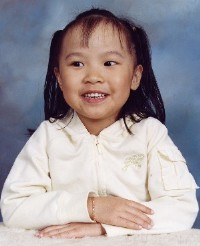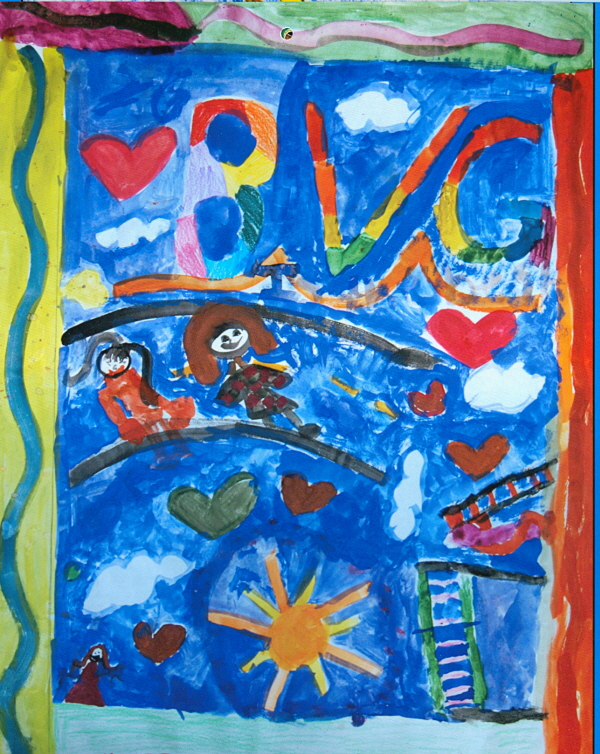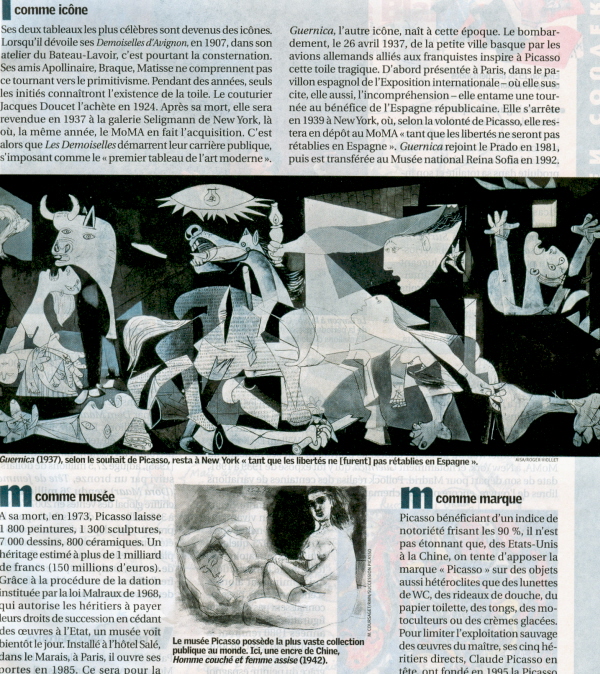|
|
Album
|
C'est
l'événement artistique de l'année: l'exposition du Grand Palais, à Paris, confronte
le maître du xxe siècle à ceux qui l'ont inspiré, du Greco à Van Gogh,
de Velazquez à Manet. Ou comment ce volutionnaire sut faire sienne
l'histoire de la peinture pour mieux la réinventer. Un rendez-vous
exceptionnel qui valait bien ce dossier spécial.
Một
biến cố nghệ thuật trong năm: Triển lãm tại Đại Cung Điện ở Paris: cuộc đụng
đầu giữa Bậc Thầy của thế kỷ, Picasso, với những sư phụ của Thầy: Từ
Greco tới Van Gogh, từ Velasquez tới Manet. Hay là, bằng cách nào nhà
cách mạng nghệ thuật lấy cuộc đời của mình làm lịch sử nghệ thuật, để
tái sinh nó.
Một cuộc gặp gỡ đặc biệt xứng đáng một số báo đặc biệt:
Một cuộc triển lãm đặc biệt
Hành trình của một thiên tài
Những tuyệt tác được giải mã.
Picasso and the masters
A garden of visual delights
Oct
9th 2008 | PARIS
From The Economist print edition
The
men who made cubism
Họ làm
ra lập thể
RARE
is the event that pushes the financial crisis off the front pages. But
“Picasso et les Maîtres”—a visual conversation between the cubist
master and the great painters that shaped him—claims that honour.
Ten rooms are devoted to ten themes at the Grand Palais, where the bulk
of the exhibition is displayed: self-portraits, colours, still-lifes,
variations, portraits, nudes. In each room, works by Picasso join those
of the masters he cannibalised. Some 210 masterpieces—by El Greco,
Goya, Ingres, Manet, Poussin, Rembrandt, Renoir, Van Gogh, Velázquez
and others—have been gathered from collections the world over.
Inexpertly handled, the exercise might have been reductive. Certainly,
from 1950 to 1963, with his “variations”, Picasso analysed,
deconstructed, digested and reinvented the great works of others in an
explicit and systematic way. In “Picasso et les Maîtres”, the
descendant meets its original. So Velázquez’s 1653 portrait in oil of
the Infanta Maria Marguerita hangs alongside Picasso’s geometric riot
of yellow, red and green of the same subject. The visitor has to head
to the other museums to find Manet’s “Déjeuner sur l’Herbe” and
Delacroix’s “Femmes d’Alger”, along with Picasso’s variations, but the
digression repays the effort.
The exhibition deftly avoids a two-dimensional confrontation between
simple pairs of paintings. The thematic collections act almost like a
hall of mirrors, reflecting layered influences over the centuries. In
the room devoted to nudes, Ingres’s silky and voluptuous “Odalisque en
Grisaille” and Goya’s “Maja Desnuda” meet Picasso’s roughly textured
warped nudes as well as Manet’s 1863 nude, “Olympia”, which caused a scandal of
its own at the time. The juxtaposition shocks, reviving a sense of
insolence. Picasso shattered convention by mastering tradition. Here,
in a unique exhibition that will not be shown like this elsewhere, they
are reunited, and to breathtaking effect.
“Picasso et les Maîtres” is at the Galeries Nationales du Grand Palais,
the Musée du Louvre and the Musée d’Orsay, Paris, until February
Hiếm sự kiện đẩy
cơn khủng hoảng tài chính ra khỏi trang nhất, những ngày này. Vậy mà có
đây. Picasso
và những bậc Thầy: Cuộc triển lãm tranh tại Galeries Nationales du
Grand
Palais, the Musée du Louvre and the Musée d’Orsay, Paris, until February.
In
“Picasso et les Maîtres”, the descendant
meets its original. Trong cuộc triển lãm, đệ tử gặp sư phụ.
C'est l'événement artistique
de l'année: l'exposition du Grand Palais, à Paris, confronte le maître du xxe
siècle à
ceux qui l'ont inspiré, du Greco à Van Gogh, de Velazquez à Manet. Ou
comment
ce révolutionnaire sut faire sienne l'histoire de la peinture pour
mieux la
réinventer.
Un rendez-vous exceptionnel
qui valait bien ce dossier spécial.
Il a incarné la modernité
absolue sans cesser de se référer à la tradition. Né vingt ans avant la
fin du
XIXe siècle, Picasso a reçu une formation académique, comme il était
alors de
règle, faisant du Prado, à Madrid, son premier contact avec l'histoire
de la
peinture, avant d'arpenter le Louvre, au début des années 1900. Ainsi
la
présence du Greco ou de Velazquez, d'Ingres ou de Poussin, ou même de
Cranach
et de Grünewald, est-elle sensible dans nombre de ses tableaux. Picasso
se
posera d'ailleurs lui-même en héritier: «Un peintre, écrit-il, a
toujours un
père et une mère. Il ne sort pas du néant.»
C'est ce dialogue artistique
que recrée, par un jeu de confrontations, l'exceptionnelle exposition Picasso et les maîtres. L'inspiration,
façon Picasso, ne fonctionne évidemment pas de façon banale. Elle ne
relève «
ni du pastiche ni de la paraphrase, mais de la réinterprétation sans
tabou ni
fétichisme », explique Anne Baldas sari, directrice du musée Picasso
et
commissaire de l'exposition. L'artiste étudie, s'approprie,
déconstruit, re
construit, s'amuse, provoque. A partir des années 1950, ce dialogue ap
paraît
d'ailleurs de façon plus systématique.
Les Femmes d'Alger, de Delacroix, Les
Ménines, de Velazquez, et Le
Déjeuner sur l'herbe, de Manet,
deviennent ainsi prétexte à de très nombreuses variations.
Picasso aurait sûrement aimé
visiter ce musée imaginaire. Déjà, en 1947, il avait été invité à
accrocher
quelquesuns de ses tableaux aux côtés d'œu vres du Louvre. Et il
avait choisi
de les confronter à Zurbaran, Delacroix et Courbet. En 1971, à
l'occasion de
son 90e anniversaire, huit de ses toiles furent exposées dans la Grande
Gale
rie du Louvre, son Arlequin voisinant avec le Gilles de Watteau. il
n'avait
alors pu cacher son émotion •
Annick
Colonna-Césari, avec
Cécile Thibaud (à Madrid)
et Marion Festraëts Picasso et les
maitres.
Galeries nationales du Grand Palais, Paris (Ville). Du 8
octobre
2008 au 2 février 2009. Picasso/Delacroix : Femmes
d'Alger.
Musée du Louvre, Paris
(1er) Du 9 octobre au 2 février 2009. Picasso/Manet : Le
Déjeuner sur l'herbe. Musée d'Orsay, Paris (Vile). Du 8
octobre au
lerfévrier
2009.
*
Một
biến cố nghệ thuật trong năm: Triển
lãm tại Đại Cung Điện ở Paris:
cuộc đụng đầu giữa Bậc Thầy của thế kỷ, Picasso, với những sư phụ của
Thầy: Từ
Greco tới Van Gogh, từ Velasquez tới Manet. Hay là, bằng cách nào nhà
cách mạng
nghệ thuật lấy cuộc đời của mình làm lịch sử nghệ thuật, để tái sinh nó.
Một cuộc gặp gỡ đặc biệt xứng đáng một số báo đặc biệt.
Một cuộc triển lãm đặc biệt
Hành trình của một thiên tài
Những tuyệt tác được giải mã.
Ông
đã thể hiện hiện
đại tính tuyệt đối trong khi
không ngừng qui chiếu về truyền thống. Sinh hai mươi năm trước trước
tận
cùng thế kỷ 19, Picasso đã được đào tạo theo tinh thần hàn lâm, đúng
bài bản thời của
ông, và Prado, ở Madrid, là vị thầy vỡ lòng đầu tiên của ông, với lịch
sử hội
họa, trước khi ông sải bước tại viện bảo tàng Louvre, những năm đầu
thập niên 1900. Và sau đó là sự hiện diện của những bậc thầy khác, ở
trong
nhiều bức tranh của ông. Ông tự coi mình là kẻ thừa kế: "Họa sĩ, luôn
có
bố và mẹ. Anh ta đâu đến từ hư vô".
*
Đời
của ông là tác phẩm của ông.
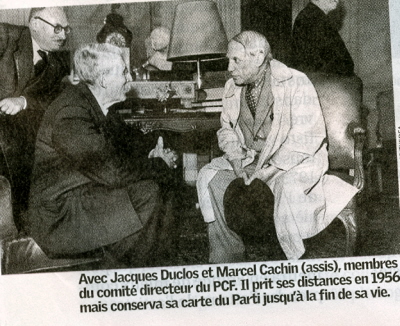
Nhà nghệ sĩ hiện đại
lớn lao nhất
là nhân vật của một sử thi trải dài một thế kỷ sáng tạo, với những xáo
trộn lịch
sử, những gặp gỡ. Giai thoại về ông ngày càng sống động, ba mươi lăm
năm sau
khi ông mất. Hàng ngàn bài viết về tiểu sử, tác phẩm, những cuộc triển
lãm tác
phẩm, từ Âu sang Á, tới tận Corée và Ukraine…
Không có vị khổng lồ nào của nghệ thuật hiện đại, Matisse, Cézanne, hay
Braque
đạt tới được tầm vóc huyền thoại như Picasso.
Phải nói là sự hiện hữu toàn
diện của Picasso được đặt dưới dấu ấn của sự ngoại khổ, không đo đếm
được, quá
tầm kích. Ông là nhân vật của một sử thi trong đó nghệ thuật và đời
sống xoắn
xuýt lấy nhau, sự khốn khổ và vinh quang, lịch sử lớn và lịch sử nhỏ.
Thiên tài
phát triển sớm, được ông bố, giáo sư nghệ thuật, đào tạo, ông chẳng mấy
chốc
được gọi là “Tiểu Goya”. Tài năng khiến ông "xém một tí" là trở thành
họa sĩ cổ điển lớn lao, nếu không kịp thời tránh thoát, để tự tìm ra
một số
phận cho mình.
Trong số phận đó, có cả cái thẻ Đảng, giữ cho đến khi chết!
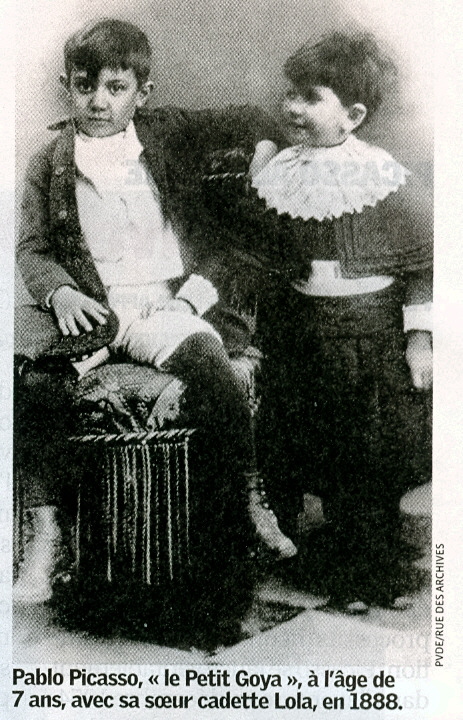

|
|
